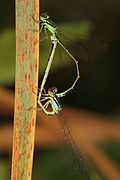| Eastern forktail | |
|---|---|
 | |
| Adult male | |
 | |
| Adult female | |
| Scientific classification | |
| Kingdom: | Animalia |
| Phylum: | Arthropoda |
| Class: | Insecta |
| Order: | Odonata |
| Suborder: | Zygoptera |
| Family: | Coenagrionidae |
| Genus: | Ischnura |
| Species: | I. verticalis |
| Binomial name | |
| Ischnura verticalis | |
 | |
Eastern forktail (Ischnura verticalis) is a member of the damselfly family Coenagrionidae. [3] [4]




